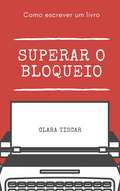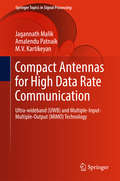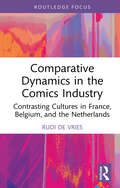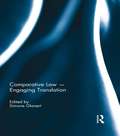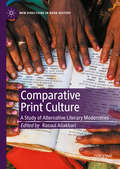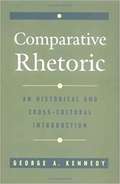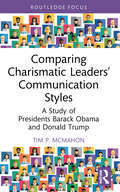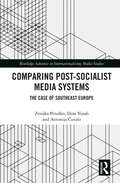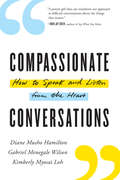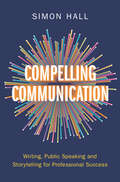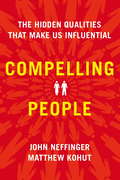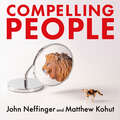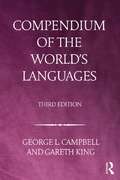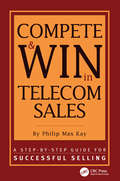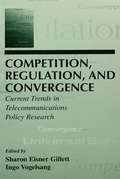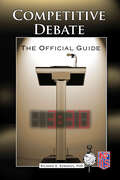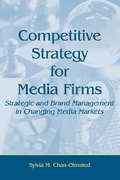- Table View
- List View
Como escrever um livro - Superar o bloqueio
by Nuno Filipe Oliveira E Sá Da Costa Lopes Clara TiscarQueres escrever? Já padeceste de um "bloqueio de escrita"? Tens medo quando olhas para a página em branco? Este livro é para ti caso te identifiques com as seguintes situações: Quero começar a escrever, mas não encontro o momento certo. Estou enrascado no meu livro, não sei como seguir em frente. Sei a história que quero contar, mas não a consigo escrever. Não bloqueei, mas falta-me motivação continuar a escrever o meu livro. Conselhos e técnicas para superar o infame bloqueio de escritor. Ferramentas e estratégias para não voltares a bloquear.
Como escrever uma postagem de blog que venda
by Richard G Lowe Jr Nícolas PoloniEscrever um artigo que induza o leitor a tomar a decisão de fazer algo é uma arte. Esse é o principal foco do livro. Você aprenderá a criar um artigo que deixe o leitor interessado, instigado, informado e ainda o faça tomar uma decisão ao terminar a leitura.
Como ganhar dinheiro com aplicativos
by Adidas WilsonO mercado de aplicativos continua crescendo a cada dia. Pessoas de todo o mundo estão usando aplicativos para estilo de vida, negócios, jogos e praticamente tudo o mais. Muitos outros estão interessados em criar seus próprios aplicativos e a constante pergunta em suas mentes é: "quanto custa?" Bem, não é tão caro. Através deste livro, você será capaz de compreender de que forma você poderá ganhar dinheiro através de aplicativos.
Compact Antennas for High Data Rate Communication: Ultra-wideband (UWB) and Multiple-Input-Multiple-Output (MIMO) Technology (Springer Topics in Signal Processing #14)
by Amalendu Patnaik M. V. Kartikeyan Jagannath MalikThis book discusses the development of promising technologies for compact antennas for high data-rate communications. It discusses and analyzes the design of compact ultra-wideband (UWB) and multiple input, multiple output (MIMO) antennas, providing essential know-how for designers, practicing engineers and scientists. These wireless communication technologies enable consumers to have convenient access to a wide range of services - anytime, anywhere. And the introduction of wireless mobile access points eliminates the limitations to communication imposed by geographical location. The Internet has allowed people to access and share information much more rapidly, but in order to achieve higher data rates with the limited available resources and imposed constraints, wireless communication technology needs to be pushed beyond the physical limits of the propagation channel. This book contributes to achieving this goal.
Comparative Dynamics in the Comics Industry: Contrasting Cultures in France, Belgium, and the Netherlands (Routledge Focus on Business and Management)
by Rudi de VriesDue to the enormous cultural and economic impact of the Marvel movies, manga, and anime, research on the comics industry is growing, but has focused primarily on the US and Japan. This book focusses on the European comics industry to explore the complex impact of organizational and cultural differences in audience behaviours, both in the comics industry specifically and in the creative industries in general.Drawing on the author’s research on the contrasting comics culture of the Netherlands, Belgium, and France, the study uses institutional theories and organizational ecology to compare the interactions of publishing organizations with artists, audiences, and each other. It combines this with a critical approach to modernization theory to evaluate how historical, cultural, and religious factors might impact the audience for comics and how those audiences respond to and interact with this specific creative medium. The book demonstrates the benefits of using combinations of theoretical frameworks to draw out more nuanced interpretations for this and other under-researched creative industry areas.With its unique insights, this book will be of great interest to researchers in the comics industry, as well as a fascinating contribution to research in cultural-related audience behaviour for all scholars in the creative industries.
Comparative Law - Engaging Translation
by Simone GlanertIn an era marked by processes of economic, political and legal integration that are arguably unprecedented in their range and impact, the translation of law has assumed a significance which it would be hard to overstate. The following situations are typical. A French law school is teaching French law in the English language to foreign exchange students. Some US legal scholars are exploring the possibility of developing a generic or transnational constitutional law. German judges are referring to foreign law in a criminal case involving an honour killing committed in Germany with a view to ascertaining the relevance of religious prescriptions. European lawyers are actively working on the creation of a common private law to be translated into the 24 official languages of the European Union. Since 2004, the World Bank has been issuing reports ranking the attractiveness of different legal cultures for doing business. All these examples raise in one way or the other the matter of translation from a comparative legal perspective. However, in today’s globalised world where the need to communicate beyond borders arises constantly in different guises, many comparatists continue not to address the issue of translation. This edited collection of essays brings together leading scholars from various cultural and disciplinary backgrounds who draw on fields such as translation studies, linguistics, literary theory, history, philosophy or sociology with a view to promoting a heightened understanding of the complex translational implications pertaining to comparative law, understood both in its literal and metaphorical senses.
Comparative Print Culture: A Study of Alternative Literary Modernities (New Directions in Book History)
by Rasoul AliakbariDrawing on comparative literary studies, postcolonial book history, and multiple, literary, and alternative modernities, this collection approaches the study of alternative literary modernities from the perspective ofcomparative print culture. The term comparative print culture designates a wide range of scholarly practices that discover, examine, document, and/or historicize various printed materials and their reproduction, circulation, and uses across genres, languages, media, and technologies, all within a comparative orientation. This book explores alternative literary modernities mostly by highlighting the distinct ways in which literary and cultural print modernities outside Europe evince the repurposing of European systems and cultures of print and further deconstruct their perceived universality.
Comparative Public Opinion
by Cameron D. Anderson and Mathieu TurgeonThis book presents a comprehensive examination of public opinion in the democratic world. Built around chapters that highlight key explanatory frameworks used in understanding public opinion, the book presents a coherent study of the subject in a comparative perspective, emphasizing and interrogating immigration as a key issue of high concern to most mass publics in the democratic world. Key features of the book include: Covers several theoretical issues and determinants of opinion such as the effects of personality, age and life cycle, ideology, social class, partisanship, gender, religion, ethnicity, language, and media, highlighting over time the effects of political, social, and economic contexts. Each chapter explores the theoretical rationale, mechanisms of effect, and use in the scholarly literature on public opinion before applying these to the issue of immigration comparatively and in specific places or regions. Widely comparative using a nine-country sample (Australia, Canada, France, Germany, Italy, Portugal, Switzerland, the United Kingdom, and the United States of America) in the analysis of individual-level determinants of public opinion about immigration and extending to other countries like Belgium, Brazil, and Japan when evaluating contextual factors. This edited volume will be essential reading for students, scholars, and practitioners interested in public opinion, political behaviour, voting behaviour, politics of the media, immigration, political communication, and, more generally, democracy and comparative politics.
Comparative Rhetoric: An Historical and Cross-Cultural Introduction
by George A. KennedyComparative Rhetoric is the first book to offer a cross-cultural overview of rhetoric as a universal feature of expression, composition, and communication. It begins with a theory of rhetoric as a form of mental and emotional energy which is transmitted from a speaker or writer to an audience or reader through a speech or text. In the first part of the book, George Kennedy explores analogies to human rhetoric in animal communication, possible rhetorical factors in the origin of human speech, and rhetorical conventions in traditionally oral societies in Australia, the South Pacific, Africa, and the Americas.<P><P> Topics discussed include forms of reasoning, the function of metaphor, and the forms and uses of formal language. The second part of the book provides an account of rhetoric as understood and practiced in early literate societies in the Near East, China, India, Greece, and Rome, identifying unique or unusual features of Western discourse in comparison to uses elsewhere. The concluding chapter summarizes the results of the study and evaluates the validity of traditional Western rhetorical concepts in describing non-Western rhetoric. Addressing both what is general or common in all rhetorical traditions and what is unique or unusual in the Western tradition, Comparative Rhetoric is ideally suited for courses in rhetoric, rhetoric theory, the history of rhetoric, intercultural communication, linguistic anthropology, and comparative linguistics.
Comparing Charismatic Leaders’ Communication Styles: A Study of Presidents Barack Obama and Donald Trump (Routledge Focus on Communication Studies)
by Tim P. McMahonIn examining the presidencies of Barack Obama and Donald Trump, and by extension their communication styles, this book provides a foundation for understanding charismatic leadership and its potent effect on followers.The book identifies each leader’s charismatic leadership attributes, focusing specifically on communication and impression management. It presents a qualitative collection of leader observations and outcomes based on publications and audio and video recordings. By examining two distinctly different leaders, each with evidence of effective, if controversial, outcomes, it shows a spectrum of approaches to mobilizing followers.This book is suited to students and readers interested in leadership studies, leadership communication, and persuasion.
Comparing Media Systems
by Daniel C. Hallin Paolo ManciniComparing Media Systems Beyond the Western World offers a broad exploration of the conceptual foundations for comparative analysis of media and politics globally. It takes as its point of departure the widely used framework of Daniel C. Hallin and Paolo Mancini's Comparing Media Systems, exploring how the concepts and methods of their analysis do and do not prove useful when applied beyond the original focus of their "most similar systems" design and the West European and North American cases it encompassed. It is intended both to use a wider range of cases to interrogate and clarify the conceptual framework of Comparing Media Systems and to propose new models, concepts, and approaches that will be useful for dealing with non-Western media systems and with processes of political transition. Comparing Media Systems Beyond the Western World covers, among other cases, Brazil, China, Israel, Lebanon, Lithuania, Poland, Russia, Saudi Arabia, South Africa, and Thailand.
Comparing Post-Socialist Media Systems: The Case of Southeast Europe (Routledge Advances in Internationalizing Media Studies)
by Zrinjka Peruško Dina Vozab Antonija ČuvaloThis book explains divergent media system trajectories in the countries in southeast Europe, and challenges the presumption that the common socialist experience critically influences a common outcome in media development after democratic transformations, by showing different remote and proximate configuration of conditions that influence their contemporary shape. Applying an innovative longitudinal set-theoretical methodological approach, the book contributes to the theory of media systems with a novel theoretical framework for the comparative analysis of post-socialist media systems. This theory builds on the theory of historical institutionalism and the notion of critical junctures and path dependency in searching for an explanation for similarities or differences among media systems in the Eastern European region. Extending the understanding of media systems beyond a political journalism focus, this book is a valuable contribution to the literature on comparative media systems in the areas of media systems studies, political science, Southeast and Central European studies, post-socialist studies and communication studies.
Compassionate Communicating: Poetry, Prose, and Practices
by Kimberly PearceCompassionate Communication is a book that provides a more expansive view of communication and its role in increasing compassion for ourselves and others. The book advances innovative ideas and specific practices to improve our relationships and increase compassion in our lives.
Compassionate Conversations: How to Speak and Listen from the Heart
by Diane Musho Hamilton Gabriel Menegale Wilson Kimberly LohThe definitive guide to learning effective skills for engaging in open and honest conversations about divisive issues from three professional mediators.When a conversation takes a turn into the sometimes uncomfortable and often contentious topics of race, religion, gender, sexuality, and politics, it can be difficult to know what to say or how to respond to someone you disagree with. Compassionate Conversations empowers us to transform these conversations into opportunities to bridge divides and mend relationships by providing the basic set of conflict resolution skills we need to be successful, including listening, reframing, and dealing with strong emotions. Addressing the long history of injury and pain for marginalized groups, the authors explore topics like social privilege, power dynamics, and, political correctness allowing us to be more mindful in our conversations. Each chapter contains practices and reflection questions to help readers feel more prepared to talk through polarizing issues, ultimately encouraging us to take risks, to understand and recognize our deep commonalities, to be willing to make mistakes, and to become more intimate with expressing our truths, as well as listening to those of others.
Compassionate Leadership: How to create and maintain engaged, committed and high-performing teams
by Manley HopkinsonForcing compliance is easy. Anyone can 'make' another do a task or a job. It will get done, but when, and to what standard? High performance and, more importantly, sustained high performance can only come from engagement with and commitment to the job in hand. This book will introduce you to the art of compassionate leadership - the art of getting the best for and out of people through the fulfilment of self-worth. It will show leaders how to give their teams a real sense of purpose and direction in order to motivate and inspire them to perform at a high level. To illustrate his message, author Manley Hopkinson draws on his background as a board member of companies including ATLAS Consortium and Hewlett Packard Defence UK, his career as an inspirational speaker and his adventure experiences as skipper in the BT Global Challenge (a round the world yacht race) and The Polar Race (an expedition style race to the Magnetic North Pole).
Compelling Communication
by Simon HallDo your communication skills let you down? Do you struggle to explain and influence, persuade and inspire? Are you failing to fulfil your potential because of your inability to wield words in the ways you'd like? This book has the solution. Written by a University of Cambridge Communication Course lead, journalist and former BBC broadcaster, it covers everything from the essentials of effective communication to the most advanced skills. Whether you want to write a razor sharp briefing, shine in an important presentation, hone your online presence, or just get yourself noticed and picked out for promotion, all you need to know is here. From writing and public speaking, to the beautiful and stirring art of storytelling, and even using smartphone photography to help convey your message, this invaluable book will empower you to become a truly compelling communicator.
Compelling People: The Hidden Qualities That Make Us Influential
by John Neffinger Matthew Kohut'This is not just another pop-psych book: it's the first book to capture and share the insights from all the recent groundbreaking research on how we judge and persuade each other. And it translates that into simple, practical terms anyone can use to build more effective relationships at the office or home' Amy CuddyHOW PEOPLE JUDGE YOU - AND HOW TO COME OUT LOOKING GOOD Everyone wants to know how to be more influential. But most of us don't really think we can have the kind of magnetism or charisma that we associate with someone like Bill Clinton or Oprah Winfrey unless it comes naturally. In Compelling People - now required reading and Harvard Business School - John Neffinger and Matthew Kohut show that this isn't something we have to be born with, it's something we can learn. They trace the path to influence through a balance of strength and warmth. Each seems simple, but only a few of us figure out the tricky task of projecting both at once. Drawing on cutting-edge social science research as well as their own work with Fortune 500 executives, members of Congress, TED speakers and Nobel Prize winners, Compelling People explains how we size each other up - and how we can learn to win the admiration, respect, and affection we desire.
Compelling People: The Hidden Qualities That Make Us Influential
by John Neffinger Matthew Kohut'This is not just another pop-psych book: it's the first book to capture and share the insights from all the recent groundbreaking research on how we judge and persuade each other. And it translates that into simple, practical terms anyone can use to build more effective relationships at the office or home' Amy CuddyHOW PEOPLE JUDGE YOU - AND HOW TO COME OUT LOOKING GOOD Everyone wants to know how to be more influential. But most of us don't really think we can have the kind of magnetism or charisma that we associate with someone like Bill Clinton or Oprah Winfrey unless it comes naturally. In Compelling People - now required reading at Harvard Business School - John Neffinger and Matthew Kohut show that this isn't something we have to be born with, it's something we can learn. They trace the path to influence through a balance of strength and warmth. Each seems simple, but only a few of us figure out the tricky task of projecting both at once. Drawing on cutting-edge social science research as well as their own work with Fortune 500 executives, members of Congress, TED speakers and Nobel Prize winners, Compelling People explains how we size each other up - and how we can learn to win the admiration, respect, and affection we desire.
Compendium of the World's Languages
by Gareth King George L. CampbellThis third edition of Compendium of the World’s Languages has been thoroughly revised to provide up-to-date and accurate descriptions of a wide selection of natural language systems. All cultural and historical notes as well as statistical data have been checked, updated and in many cases expanded. Presenting an even broader range of languages and language families, including new coverage of Australian aboriginal languages and expanded treatment of North American and African languages, this new edition offers a total of 342 entries over nearly 2000 pages. Key features include: Complete rewriting, systematization and regularisation of the phonology sections Provision of IPA symbol grids arranged by articulatory feature and by alphabetic resemblance to facilitate use of the new phonology sections Expansion of morphology descriptions for most major languages Provision of new illustrative text samples Addition of a glossary of technical terms and an expanded bibliography Comparative tables of the numerals 1-10 in a representative range of languages, and also grouped by family Drawing upon a wealth of recent developments and research in language typology and broadened availability of descriptive data, this new incarnation of George Campbell’s astounding Compendium brings a much-loved survey emphatically into the twenty-first century for a new generation of readers. Scholarly, comprehensive and highly accessible, Compendium of the World’s Languages remains the ideal reference for all interested linguists and professionals alike.
Compete and Win in Telecom Sales: A Step-by -Step Guide for Successful Selling
by Philip Max KayFor anyone ready to launch a successful career in sales for telecom equipment, services and technologies, or for veterans ready to break through to a higher level, this book provides a practical eight-step program for successful selling.
Competing through ICT Capability
by Mitsuru KodamaProposes that video communications tools are a form of infrastructure that enhance the creation of new knowledge which transcends space and time in business activities. Illustrates that the dynamic relationship of four elements of ICT capability promote the formation of business networks and the development of knowledge communities.
Competition, Regulation, and Convergence: Current Trends in Telecommunications Policy Research (LEA Telecommunications Series)
by Ingo Vogelsang Sharon Eisner GillettThe telecommunications industry has experienced dynamic changes over the past several years, and those exciting events and developments are reflected in the chapters of this volume. The Telecommunications Policy Research Conference (TPRC) holds an unrivaled place at the center of national public policy discourse on issues in communications and information. TPRC is one of the few places where multidisciplinary discussions take place as the norm. The papers collected here represent the current state of research in telecommunication policy, and are organized around four topics: competition, regulation, universal service, and convergence. The contentious competition issues include bundling as a strategy in software competition, combination bidding in spectrum auctions, and anticompetitive behavior in the Internet. Regulation takes up telephone number portability, decentralized regulatory decision making versus central regulatory authority, data protection, restrictions to the flow of information over the Internet, and failed Global Information Infrastructure initiatives. Universal service addresses the persistent gap in telecommunications from a socioeconomic perspective, the availability of competitive Internet access service and cost modeling. The convergence section concentrates on the costs of Internet telephony versus circuit switched telephony, the intertwined evolution of new services, new technologies, and new consumer equipment, and the politically charged question of asymmetric regulation of Internet telephony and conventional telephone service.
Competitive Debate: The Official Guide
by Richard EdwardsThe bible for debaters and their coaches. Nearly every high school and college in America has a debate club and/or a debate team. There are hundreds of competitions at the county and state level, culminating in heated national competitions. Yet, at many high schools and colleges, coaches are drawn from the history or English departments with little or no experience in the highly structured procedures of this popular discipline. And while competitive debate has been growing each year as a prime academic activity, there have been no popular handbooks to help students and coaches prepare for contests effectively and efficiently. Practical and authoritative, this guide includes not only tips and guidelines for effective preparation and delivery, but full-length, actual transcripts of successful competitions in each format. Endorsed by the two national governing bodies for competitive debate—the National Federation of State High School Associations and the National Forensic League—and priced for the budget-conscious student and high school teacher alike, Competitive Debate: The Official Guide is set to become the instructional &“bible&” for tens of thousands of present and future debaters and their coaches. Inside, Dr. Richard Edwards—award-winning debate coach, professor, former competitive debate judge, and author—leads readers through the three popular formats of competitive debate: • Policy Debate • Lincoln-Douglas Debate • Public Forum Debate
Competitive Dynamics in the Mobile Phone Industry
by Claudio GiachettiThis book explores which kind of competitive moves and countermoves have been taken by mobile phone vendors like Nokia, Samsung, Motorola and Apple, as well as emerging rivals from developing countries, to defend their competitive position over the industry life cycle, and which factors have driven these actions.
Competitive Strategy for Media Firms: Strategic and Brand Management in Changing Media Markets (Routledge Communication Series)
by Sylvia M. Chan-OlmstedCompetitive Strategy for Media Firms introduces the concepts and analytical frameworks of strategic and brand management, and illustrates how they can be adapted according to the characteristics of distinct media products. Working from the premise that all media firms must strategize in response to the continuing evolution of new media, author Sylvia M. Chan-Olmsted offers applications of common business approaches to the products and components of the electronic media industry, and provides empirical examinations of broadcast, multichannel media, enhanced television, broadband communications, and global media conglomerate markets. This insightful and timely volume provides a thorough review of current concepts and industry practices, and serves as an essential primer for the application of business models in media contexts. As a realistic and integrated approach to media industry studies, this volume has much to offer researchers, scholars, and graduate students in media economics and management, and will be an important reference for industry practitioners.
